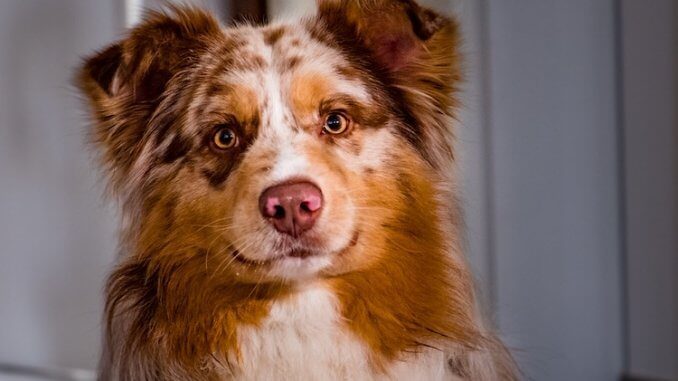
On a crisp autumn morning, while volunteering at a local dog agility competition, I encountered a duo that left a lasting impression. The team was a lively Border Collie Australian Shepherd mix and her owner. Watching them navigate the course with such precision and teamwork was a testament to the breed’s capabilities. This mix, often lovingly referred to as a “Border Aussie,” brings together the boundless energy of the Border Collie with the steadfast loyalty of the Australian Shepherd.
What struck me most was the seamless communication between the dog and her owner. It highlighted the Border Aussie’s keen intelligence and eagerness to work alongside their human partners. These dogs are not just pets. They are collaborators, always ready to tackle the next challenge with enthusiasm.
But it’s not all about fun and games. These dogs come with a set of needs that require a committed owner. They thrive on mental stimulation and physical activity. So, if you’re thinking of welcoming a Border Aussie into your life, be prepared for long walks, interactive play, and, most importantly, an unbreakable bond. Read on to learn more.
TABLE OF CONTENTS
- Border Collie Australian Shepherd Mix Quick Breed Summary
- Origin of the Border Collie Australian Shepherd Mix
- Border Collie Australian Shepherd Mix Physical Appearance
- Border's Aussie's Temperament
- Border Collie Australian Shepherd Mix Care Guide
- How to Train a Border Collie Australian Shepherd Mix
- Common Health Problems in Border Aussies
- Costs of Ownership
- FAQs: A Deeper Understanding of Border Collie Australian Shepherd Mix
- Is the Border Collie Australian Shepherd Mix Right for You?
- Other Border Collie and Australian Shepherd Mixes
Border Collie Australian Shepherd Mix Quick Breed Summary
Origin of the Border Collie Australian Shepherd Mix
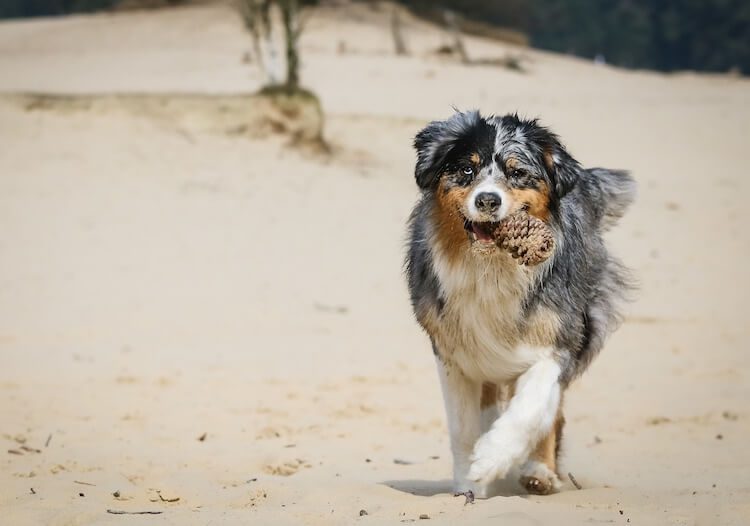
Let me take you back to where it all started for the Border Collie Australian Shepherd mix, a blend I’ve come to admire deeply. This journey involves two remarkable breeds, each with a story that’s as intriguing as their abilities. Understanding their origins gives us a glimpse into the making of this extraordinary mix.
The Border Collie: A Legacy of Intelligence
The Border Collie’s story begins on the borderlands between Scotland and England. Here, they became shepherding legends. Known for their intense stare, they control flocks with precision. Their intelligence is unmatched, often considered the smartest of all dog breeds.
It’s this brainpower that makes Border Collies exceptional. They thrive on solving problems and learning new tasks. Agility, obedience, you name it, they excel. This breed’s history is steeped in working alongside humans, a trait they carry proudly.
The Australian Shepherd: A Misnamed Marvel
Contrary to their name, Australian Shepherds have an American heritage. Born from the ranches of the Western United States, they were indispensable to cowboys. Their herding skills are top-notch, managing livestock with ease. Their colorful coats and striking eyes only add to their appeal.
Aussies are more than just workers. They’re loyal companions, always ready for an adventure. Whether it’s hiking or herding, they’re in their element. Their origins in the rugged landscapes of the West shaped their resilient and versatile nature.
The Birth of the Border Aussie
So, when did the Border Collie and Australian Shepherd mix come into the picture? It’s hard to pinpoint an exact moment. This mix likely originated from a desire to combine their remarkable traits. The goal was simple: create a dog with unmatched herding abilities and adaptability.
The Border Aussie isn’t just a product of its parent breeds’ physical abilities. It’s their mental acumen that truly sets this mix apart. Breeders saw the potential for a dog that could excel in a variety of roles. From service dogs to family pets, the Border Aussie fits seamlessly.
Kennel Club Recognition
Now, when it comes to the recognition of our beloved Border Aussie by kennel clubs, things get a bit interesting. Given their mixed breed status, they’re often left out of the purebred registries. Clubs like the American Kennel Club (AKC) focus on purebreds, so you won’t find the Border Aussie on their list.
However, not all hope is lost for our mixed-breed friends. Organizations like the American Canine Hybrid Club (ACHC) and the International Designer Canine Registry (IDCR) welcome them with open arms. These clubs recognize the value and uniqueness of hybrid breeds like the Border Aussie, offering them a chance to shine.
Border Collie Australian Shepherd Mix Physical Appearance
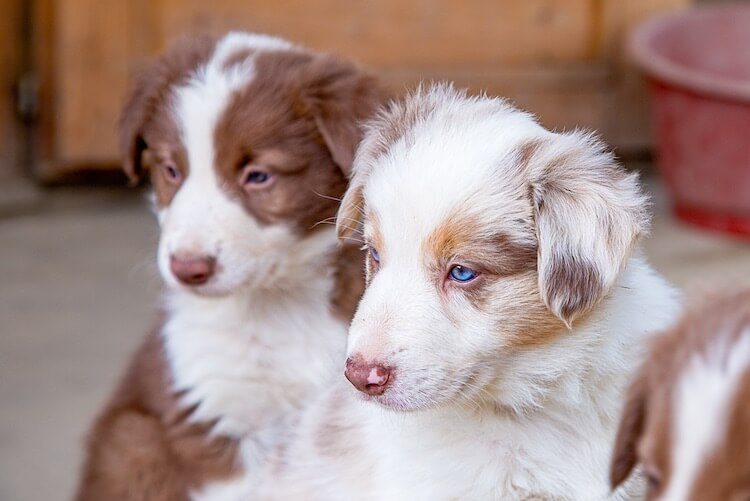
When you first lay eyes on a Border Collie Australian Shepherd mix, you’re met with a stunning display. Their appearance is a delightful mix of their parent breeds. It’s like they’ve handpicked the best features from both sides.
Captivating Physical Presence
The first thing you notice about the Border Collie Australian Shepherd mix is their commanding presence. They carry themselves with a confidence that’s hard to ignore. Medium to large in stature, these dogs exude strength and agility. Their height ranges from 18 to 21 inches for females and 19 to 23 inches for males, a size that showcases their balanced proportions and muscular build.
As for their weight, expect a Border Aussie to be quite the substantial companion, weighing in at 30 to 65 pounds. This weight range reflects their robustness, a trait inherited from their hardworking ancestors. It’s this solid foundation that equips them for a variety of physical activities, from herding to agility courses.
A Tapestry of Colors and Textures
Diving deeper into their appearance, the coat of a Border Collie Australian Shepherd mix is nothing short of mesmerizing. The texture is typically dense and can range from straight to slightly wavy, providing ample protection against the elements. This practical yet beautiful coat comes in an array of colors and patterns, making each dog uniquely stunning.
You might find them sporting the classic black and white markings of the Border Collie or the distinctive blue merle and red merle patterns of the Australian Shepherd. Some display a rich blend of both, with splashes of tan, brown, and even sable. The variety in their coat coloration is a testament to the diverse genetic heritage of this mix. Each Border Aussie’s coat tells a story of its lineage, adding to the allure of this captivating breed.
Border’s Aussie’s Temperament
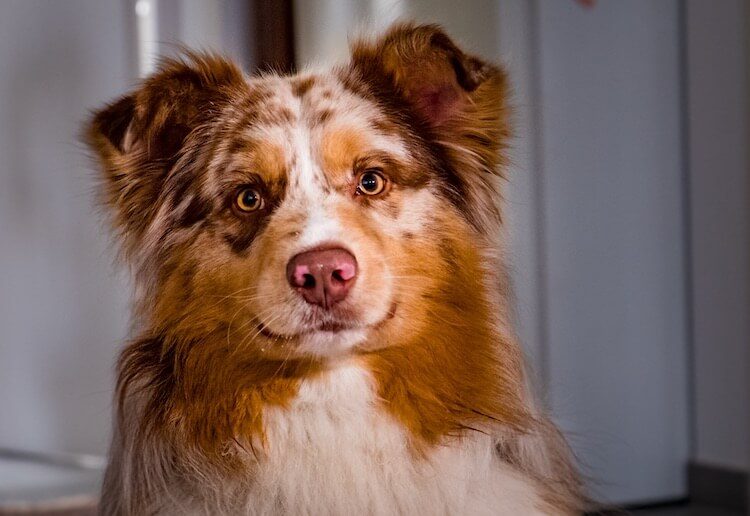
When you delve into the temperament of a Border Collie Australian Shepherd mix, you’re exploring a world of complex emotions and capabilities.
The Heart of a Worker
At the core of every Border Aussie lies the heart of a true worker. Their drive is something to behold. Born from two of the most diligent herding breeds, this mix inherits an unyielding work ethic. They’re not just eager to please; they need tasks to feel fulfilled.
This zeal for work translates into high energy levels. A Border Aussie is always ready for action, be it a game of fetch or a challenging training session. Their intelligence shines through in every activity, always looking for ways to outsmart and impress.
A Loyal Companion
Beyond their work ethic, Border Aussies are incredibly loyal. They form deep bonds with their families, becoming devoted companions. This loyalty means they’re protective, always keeping a watchful eye on their loved ones. Yet, they’re not overly aggressive. They balance their protective instincts with a gentle nature, especially around those they trust.
Their social temperament does come with a need for companionship. Border Aussies don’t like being left alone for long periods. They thrive on interaction, whether with humans or other pets. This need for social engagement makes them excellent family dogs, always ready to be part of the action.
Sensitivity and Intelligence
What truly sets Border Aussies apart is their sensitivity coupled with intelligence. They’re not just smart; they’re intuitive. They can pick up on subtle cues, making them excellent at reading their owners’ emotions. This sensitivity, however, means they need a gentle hand in training. Harsh methods don’t work with these sensitive souls.
Their intelligence is a double-edged sword. It keeps them mentally stimulated but also means they get bored easily. A bored Border Aussie can become a mischievous one. Keeping them engaged with new tricks and tasks is key to their well-being. It’s this blend of sensitivity and smarts that makes the Border Aussie a truly remarkable companion.
Border Collie Australian Shepherd Mix Care Guide
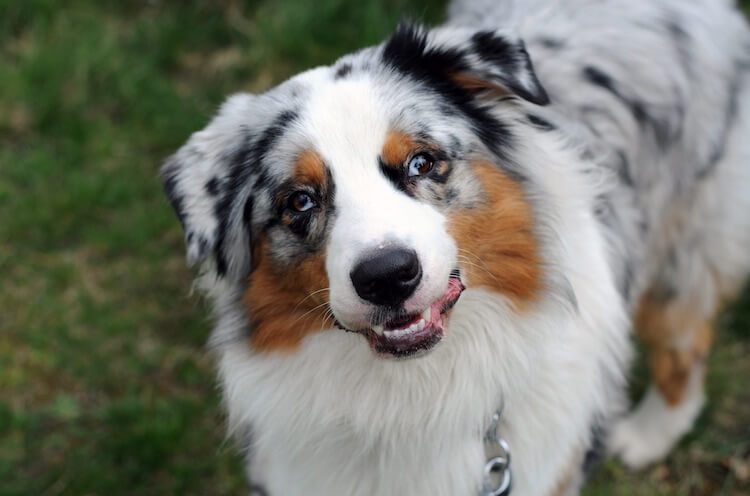
Caring for a Border Collie Australian Shepherd mix is a rewarding journey that requires attention to detail. From their diet to their grooming needs, and from physical exercise to mental challenges, each aspect of their care is crucial for their well-being.
Feeding: Nourishing the Body and Soul
Choosing the right food for your Border Aussie is crucial. They’re like athletes in the dog world, needing a diet that supports their energy levels. Look for foods high in quality proteins and fats, with minimal fillers. Remember, every dog is unique. Some may thrive on commercial diets, while others might do better on a tailored raw or home-cooked regimen. Always consult your vet to make the best choice for your furry friend.
Feeding routines are just as important as the food itself. Regular, consistent meal times help regulate their metabolism and energy. It’s tempting to spoil them with treats, especially when those eyes beg. But moderation is key. Too many treats can lead to weight gain, upsetting their nutritional balance. Use healthy options like carrots or green beans for low-calorie treats.
As your Border Aussie ages, their dietary needs will change. Puppies require diets rich in calories and nutrients for growth. Adult dogs need balanced meals to maintain their health and vigor. Senior dogs may need adjustments for lower activity levels or health issues. Regular check-ups with your vet ensure their diet evolves with their changing needs.
Grooming: More Than Skin Deep
Grooming a Border Aussie isn’t just about keeping them pretty; it’s about maintaining their health. Their coats are designed to protect them from the elements, but they require regular care to stay in top condition. Brushing a few times a week reduces shedding and prevents matting. It’s also a great way to check for any skin issues or parasites.
Bathing your Border Aussie should be an occasional affair, reserved for when they’re truly dirty. Over-bathing can strip their coat of natural oils, leading to dry, irritated skin. When bath time does roll around, choose a mild dog-specific shampoo to keep their coat and skin healthy.
Don’t forget the little things in grooming. Nail trims are essential to prevent discomfort and mobility issues. Regular ear checks prevent infections, especially in dogs that love to swim. Oral hygiene is vital too; brushing their teeth or providing dental chews helps keep their gums and teeth healthy, warding off bad breath and dental diseases.
Exercise: A Must for Body and Mind
Exercise is the cornerstone of a happy, healthy life for a Border Aussie. These dogs have energy to spare, and they need an outlet. Daily walks are non-negotiable, but they’re just the start. Incorporate running, hiking, or playtime in the yard to keep things interesting. It’s not just about physical exertion; it’s about bonding and exploring the world together.
But it’s not all about physical prowess. Border Aussies are social creatures, thriving on interaction with other dogs and people. Regular visits to the dog park or playdates with canine pals provide both physical and social stimulation. It helps them develop well-rounded personalities, avoiding behavioral issues linked to isolation or boredom.
Seasons and weather can affect your exercise routine, but don’t let them halt your activities. Indoor games, obstacle courses, or even treadmill walks can keep them active during inclement weather. It’s about adaptability and creativity in meeting their exercise needs, regardless of external conditions.
Mental Stimulation: Keeping the Wheels Turning
Border Aussies are thinkers, always looking for puzzles to solve. Their mental health is just as important as their physical well-being. Incorporating training sessions into their daily routine not only teaches them new skills but also provides essential mental stimulation. Keep these sessions short, fun, and varied to hold their interest.
Interactive toys and puzzles are great for times when you can’t be hands-on. They keep your Border Aussie’s mind engaged, turning potential boredom into a rewarding challenge. Rotate these toys to keep them fresh and interesting, preventing your dog from losing interest.
Never underestimate the power of social learning and exploration. New environments, different people, and varied experiences stimulate their minds. It’s about exposing them to the world in a controlled, positive way. This not only broadens their horizons but also reinforces their training.
How to Train a Border Collie Australian Shepherd Mix
Their intelligence and eagerness to please make the training journey fascinating. According to this breed guide, their intelligence and eagerness to please make the training journey fascinating. I’ve had my share of training sessions with these mixes, and each time, I’m amazed at their capabilities.
Laying the Groundwork
Starting with basic commands is like teaching the ABCs. Sit, stay, come – these are the building blocks of good behavior. Positive reinforcement is the golden rule here. A little treat here, a cheerful “good job!” there, and you’re on your way to success. And let’s not forget patience; it’s as important as the treats you’re handing out.
Consistency is the name of the game. Imagine trying to learn something new, but the rules keep changing. Confusing, right? That’s how your Border Aussie feels with mixed signals. Stick to the same words and gestures, and you’ll be amazed at how quickly they catch on. Short, regular training sessions are better than marathon ones that leave you both drained.
Playing to Their Strengths
Now, these dogs have herding in their blood, which can be quite the spectacle when channeled correctly. Think agility courses or even herding balls designed for dogs. It’s like watching a natural-born athlete in action. And it’s not just about physical prowess; these activities keep their brains ticking too.
Incorporating brain games into the mix keeps their intellect sharp. Border Aussies love a good challenge, so puzzle toys and learning new tricks can be a blast for them. It’s about keeping both their bodies and minds engaged, making every day an adventure.
Beyond the Basics: Socialization and Beyond
Early socialization is like giving your dog a passport to the world. It opens them up to new experiences, helping them become well-adjusted adults. Dog parks, pet-friendly cafes, and neighborhood strolls can be great social outings. Watching them interact and learn the ropes of doggy etiquette is both rewarding and essential for their development.
For those who love a challenge, advanced training can be an exciting frontier. Obedience trials, flyball, you name it – Border Aussies are up for it. It’s not just about the ribbons or the accolades; it’s about bonding with your dog and watching them thrive. It’s a journey of mutual respect and understanding, filled with high fives and happy tails.
Common Health Problems in Border Aussies
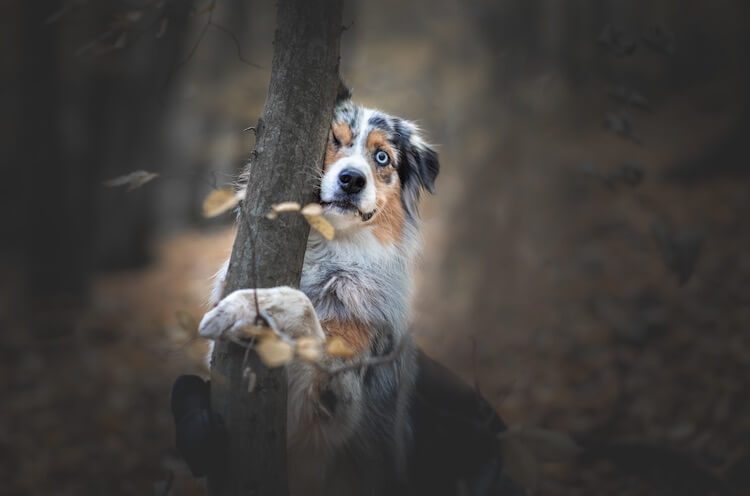
Hip Dysplasia
Hip dysplasia is a condition that can greatly affect your dog’s quality of life. It’s a genetic malformation where the ball and socket of the hip joint don’t fit or develop properly, leading to pain, lameness, and osteoarthritis. Signs include difficulty in standing up, reluctance to run or jump, and a noticeable limp. It’s especially concerning in active breeds like the Border Aussie, given their high energy levels.
- Keep your dog lean to minimize strain on the hips.
- Engage in gentle exercises that don’t overexert the joints, such as swimming.
- Consider dietary supplements like glucosamine, chondroitin, and Omega-3 fatty acids, which can support joint health.
- Invest in a supportive orthopedic bed to provide comfort and relief during rest.
Collie Eye Anomaly
Collie Eye Anomaly (CEA) is a hereditary condition that affects the development of the eye, which can range from mild to severe, possibly leading to blindness. Unfortunately, there are no outward symptoms for CEA, making it difficult to detect without a thorough veterinary examination.
- Prioritize genetic testing if you’re considering breeding your Border Aussie.
- Schedule regular comprehensive eye exams with your vet to monitor the condition.
- Adjust your home environment to safeguard a dog with vision impairment, preventing accidents and injuries.
Epilepsy
Epilepsy in dogs is akin to the human condition, characterized by recurrent seizures that vary in severity. Witnessing your dog experiencing a seizure can be frightening, but many dogs with epilepsy live full, healthy lives with proper management.
- Maintain a strict schedule for anti-epileptic medication to manage seizures.
- Keep a detailed seizure diary to help your vet tailor treatment plans.
- Implement calming techniques and create a stress-free environment to potentially reduce seizure frequency.
- Regular vet visits are essential to monitor the condition and adjust medications as needed.
Allergies
Allergies can manifest in various ways in Border Aussies, from itchy skin and ear infections to gastrointestinal discomfort. These reactions can be triggered by a range of factors, including environmental allergens, certain foods, or flea bites.
- Work with your vet to identify specific allergens through elimination diets or allergy testing.
- Regular baths with hypoallergenic shampoos can help relieve itchy skin.
- Supplementing your dog’s diet with Omega-3 fatty acids can improve skin health and reduce inflammatory responses.
- Keeping your home clean and minimizing exposure to known allergens can help manage symptoms.
Costs of Ownership
When considering the addition of a Border Collie Australian Shepherd mix, or Border Aussie, to your family, it’s essential to look beyond the initial purchase price and understand the full financial commitment involved.
Initial Purchase Price
- From Breeders: Expect to pay between $600 and $1,000, depending on factors like the puppy’s lineage and the breeder’s reputation.
- Factors Influencing Price: Puppies from award-winning lines or with specific desirable traits may cost more.
Initial Setup Costs
- Essentials: Bed, bowls, leash, collar, and toys.
- First Medical Exams: Including vaccinations and initial check-ups.
- Total Initial Setup: Can add several hundred dollars to your initial costs.
Annual Ongoing Costs
- High-Quality Dog Food: Tailored to their energetic lifestyle.
- Routine Veterinary Care: Regular check-ups, vaccinations, and preventive medicines.
- Grooming Supplies/Services: Depending on coat type and personal preference.
- Miscellaneous: Toys, treats, and training supplies.
- Total Annual Costs: Typically over $1,000, varying with individual needs and lifestyle.
Training Expenses
- Classes or Private Trainers: Beneficial for their development, with costs varying widely based on the type and level of training.
Health-Related Expenses
- Potential Issues: Preparing for unexpected health issues, despite mixed breeds often being healthier.
- Savings or Pet Insurance: Recommended to cover unforeseen medical expenses.
FAQs: A Deeper Understanding of Border Collie Australian Shepherd Mix
What is the life expectancy of a Border Aussie?
Border Aussies typically enjoy a lifespan ranging from 12 to 15 years. Their longevity is influenced by various factors including genetics, diet, and regular exercise. Providing routine veterinary care is also vital to address any health issues early on and contribute to a longer, healthier life.
Do Border Aussies bark a lot?
Border Aussies can be vocal, particularly if they inherit the Border Collie’s tendency to communicate through barking. They may bark to alert you, during play, or when herding instincts kick in. Proper training and mental stimulation can help manage and reduce unnecessary barking.
How much do Border Aussies shed?
Border Aussies shed moderately throughout the year, with increased shedding during spring and fall as they change coats. Regular brushing, at least a few times a week, can help manage the shedding and keep their coat healthy. Investing in a good vacuum and grooming tools can make living with their shedding easier for pet owners.
Are Border Collie Australian Shepherd Mixes good with kids?
Border Aussies are known for being great with children, especially when they are raised together or properly socialized from a young age. Their playful and protective nature makes them excellent companions for kids. However, their herding instincts might lead them to nip at heels, so it’s important to supervise interactions and teach both the dog and children proper ways to interact.
Can Border Collie Australian Shepherds get along with other pets?
With proper socialization, Border Aussies can get along well with other pets, including dogs and cats. Introducing them to a variety of animals from a young age helps them learn appropriate social behaviors. It’s essential to monitor their interactions initially to ensure they’re positive and safe for all pets involved.
Is the Border Collie Australian Shepherd Mix Right for You?
Deciding if a Border Collie Australian Shepherd mix, or Border Aussie, is the right dog for you hinges on understanding this unique hybrid’s characteristics. This crossbreed brings together the keen intelligence and high energy of its parent breeds, resulting in a highly trainable, active, and loyal companion. With their herding heritage, these dogs possess an innate drive to work and play, making them well-suited to various activities and lifestyles.
Border Aussies Are For
- Active individuals or families who love outdoor activities and have the energy to match these dogs’ high levels of enthusiasm.
- People with access to a yard or open spaces where the dog can run, play, and expend energy.
- Those interested in dog sports like agility, flyball, or herding, as these activities can be greatly fulfilling for both the dog and owner.
- Committed owners ready to invest time in consistent training and enjoy building a strong bond through intellectual and physical challenges.
Border Aussies Are NOT For
- People with sedentary lifestyles or limited time for daily, active engagement with their dog.
- Apartment dwellers without a clear plan for meeting the dog’s exercise needs through daily walks, runs, and playtime.
- Individuals who are away from home for long periods regularly, as these dogs do not thrive in isolation and can develop separation anxiety.
- First-time dog owners who may not be prepared for the challenges of training and managing a highly intelligent and energetic breed.
Other Border Collie and Australian Shepherd Mixes
If you’re interested in learning about other Border Collie mixes or Australian Shepherd mixes, check out the hybrid dog breeds below.

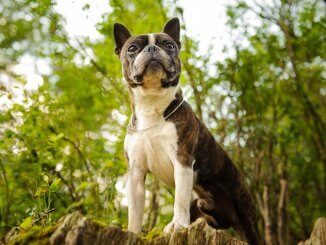
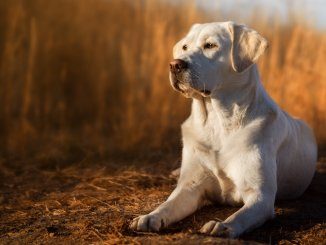
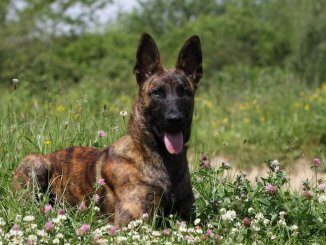
The above article is really good. Gives an insight of how to take care of each breed. Can you please also share an article about the German Shepard dog?
Hi Shweta,
We have many articles on German Shepherd dogs, you can use our search to find them.
We recently acquired a 6 month old Border Ausie. This article is right on the mark. Now if I can figure out a way to keep this new dog busy!?!?
My Border Aussie is 12 years old, a stray that adopted us. The things he loves most are puzzle games (although rotate them as that catch on quickly), sniff n’ nom (we break a soft treat into tiny pieces and throw it down the hallway for him to sniff out and eat), and a sniff mat. Additionally, as the article suggests, keep inventing new tricks (play dead is always a crowd pleaser) and that will help. Hope that helps.
I would love to buy Australian Shepherd and Border Collie mix
Last year, we received Bo. He is beautiful black and white mix. One blue eye and one brown. We have an acre for him to run and I walk him 3 miles a day. He plays fetch with the grandkids and sleeps on our couch. We also have 2 older dachshunds that from day 1 has never had a problem with them. A great family addition. I would be so sad if anything happened to him and would look for this breed again.
I have a border collie/kelpie mix. She only took three months to train us. All kidding aside, She is so smart it’s almost frightening. Smartest dog I have ever had.
I have a Border Aussie mix. I got her as a pup. I kept her in the house while a pup and until I had her spayed. Big mistake not knowing her physical activity level. She destroyed a lot before figuring out I need to buy toys and keep her active with different games. She taught me the game of catch by bringing a ball, laying it down and backing up. When I tossed in the air, she jumped up to catch it. A great activity outdoors along with frisbee. She also loved tug of war and would pull me along after dragging me off the couch. I figured this would be a life saver, if I needed her to pull me to safety. Her favorite, among others was for me roll or toss about six balls consecutive or all together. She would round each up and put them together in a pile. Her natural instinct to herd. She took on two strays at once and both turned to tail. She also learned to unlatch and open the sliding doors, on her own. Although totally amazed, I fussed and told her I wished she would learn to close them. I never blocked them from opening because I felt safer thinking if there was a fire, while I was away, she could escape. Yes, I came home from work, with the sliding door open but had chain link fencing around the back yard, she never tried to dig out from under or jump. She never bit but was cautious to strangers by instinct. She is 14 years old today, has a brown eye and a blue eye, with the blue eye filmed over with a cataract and blinded. Her hearing is impaired unless close to her and her hip is slanted to one side. She struggles to stand but does pretty good when stands and walks. I’ve always kept her veterinarian visits regular and shots updated. She is the most naturally intelligent dog, and fastest moving, I ever had. It breaks my heart to see her now that she’s gotten old and I know she’s close to her life span. I love her more than ever and pray daily that God has mercy on her.
Beautiful! Thanks! We just bought an almost 9 week pup home today. Day 1 Prepared rice with veges and evening oatmeal with carrots and sweet potato. He ate it! Some dry food as well. Finding ways to train him with his nature calls. So far every 2 hrs take him out. Wondering how often at night. Also he is choosing to sleep on floor with blanket rather than his bed. Will need a tons of help. My girls 11 and13 so far so good with playing and taking him out. What should be next steps?
My now 8-year-old Border-Aussie female that I got from a shelter/rescue when she was one year and one week old (after having been tried and rejected by probably at least 4 humans in that short time). I cannot imagine this dog living anywhere but in a virtually unrestricted rural location. I reside on 37 acres of which 26 are pasture-type land. This dog would be unhappy in an urban setting unless the owner was an avid long-distance runner. Even then, this breed really hates to be constrained by a leash. But even with all this energy both physical and mental, my girl is incredibly sweet and loyal toward her master. She is very “at home” and well-behaved as an inside dog – and I wouldn’t have it any other way. One caution to families with small children I wish to point out: my girl simply doesn’t understand small children It is as if she believes they are just “animals” that are about her same size. My grandchildren, I discovered, simply move too fast, perhaps outnumber my dog, and like to play with toys my dog wants to play with too. A family reunion at my home simply didn’t work for my dog with the young children. My girl didn’t mean to but she could easily knock down the youngsters without any agressiveness intended. Obviously, I had to protect the children
Sounds like my Roxy but she’s a golden retriever and border collie mix. Does anyone know about these mixes
l wood like to a Border collies and Australian Shepherd for the Farm Githomas@ vt.edu